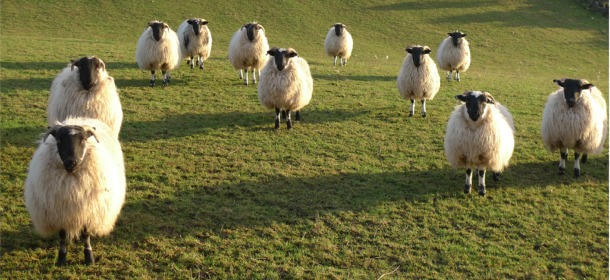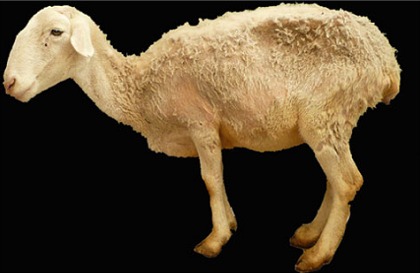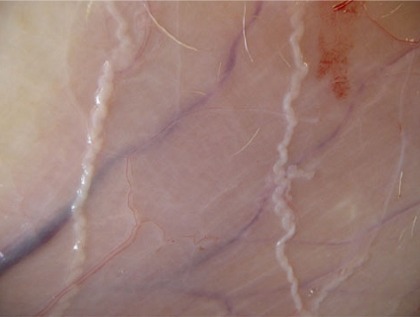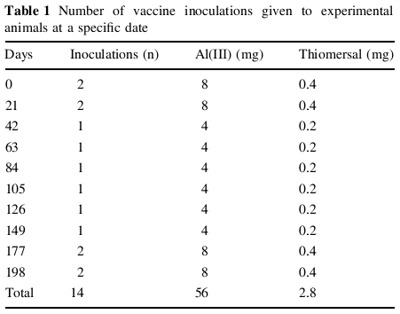Environment
Up to 100% Vaccinated Sheep Contract Chronic Neurological Syndrome: Study
Bluetongue can be a deadly disease of sheep. The standard approach to an outbreak is vaccination, vaccination, & more vaccination. A new study shows that these vaccines cause an autoimmune neurological disorder called ASIA—the same that vaccines can induce in humans. This study of Spanish sheep provides a frightening look into its frequency and severity. What does it mean in humans?

Photo by Anne Marie Cunningham
by Heidi Stevenson
The powers-that-be refuse to do studies comparing the health of vaccinated against unvaccinated children. However, Spanish animal pathology researcher, Lluís Luján, was concerned with serious health problems in sheep following mass vaccination to combat bluetongue, a viral disease spread by insects. So, a study was done to compare vaccinated versus unvaccinated sheep. The results should concern everyone. Though the percentages of affected sheep varied widely, as many as 100% of some flocks were devastated by the vaccine-induced disease called autoimmune/inflammatory syndrome induced by adjuvants (ASIA).
ASIA in Sheep
Researchers of the study, published in the journal Immunology Research, describe a syndrome that has an acute phase in only about one-half of one percent of sheep, from which most recover. However, a chronic phase develops later, and that is devasting, both in numbers and severity of illness. The economic impact is enormous. They describe it like this:
The chronic phase of the ovine ASIA syndrome is a more frequent event in our local conditions of ovine production and causes a neurological and cachectic process that has no parallel in ovine pathology, and it is a serious but unexplained concern for farmers and veterinarians. The chronic phase does not necessarily follow an acute episode, and it is
triggered by the combination of multiple alum adjuvantcontaining inoculations over the years and external stimuli.
Severity is generally related to stress. Conditions like cold weather, poor nutrition, and high levels of milk production result in significantly worse disease.

Sheep with Cachexia Resulting from ASIA
Frequency of chronic ASIA is about 50-70% of flocks, and up to 100% of the sheep within a flock. The syndrome runs through phases. It starts with “an excitatory period where affected animals show constant movement, abnormal behavior, restlessness and compulsive wool biting, resulting in animals with a very poor wool coat, a diffuse redness of the skin and thinning of the affected sheep.” During this time, the sheep exhibit a normal appetite or even an excessive one. However, this phase ends dramatically with sudden weakness, head tilting to one side, muscle tremors, and weight loss that moves toward cachexia.

Thickened Peripheral Nerves
In the terminal phase, the animals suffer from lack of response to stimuli, ataxia, and tetraplegia. They then fall into a stupor or coma, and die. They’re also known to have spontaneous abortions. They suffer from lesions of fat deposits, serous fat atrophy, ascites, hydrothorax, hydropericardium, and atrophy of skeletal muscles. Peripheral nerves become thickened in most animals. This can include primary nerves, like the sciatic, also.
Nerves in the spinal cord become necrotic. Most animals suffer from meningoencephalitis. Thickened peripheral nerves tend to be surrounded by fluid and mucous. Some demyelination and neuron loss was noted. About half the sheep were found to have membranous glomerulonephritis.
Stress conditions, such as winter lambing and cold weather, can trigger chronic ASIA. When there is an acute phase, it appears that it’s always followed by the chronic phase.
The Study
 The researchers took 6 castrated 3-month old male lambs from an organic farm. They were divided into two groups of 3, one acting as controls remaining unvaccinated, and the other vaccinated according to the schedule on the right. The vaccines were for
The researchers took 6 castrated 3-month old male lambs from an organic farm. They were divided into two groups of 3, one acting as controls remaining unvaccinated, and the other vaccinated according to the schedule on the right. The vaccines were for
a variety of ovine pathogens, including bluetongue (10 doses), Clostridium
(2 doses), Chlamydophila spp, Salmonella spp and abortive bacteria (2 doses). Each vaccine dose contained 4 mg aluminum salts and 0.2 mg thimerosal (thiomersal), for a total of 56 milligrams of aluminum and 2.8 mg of thimerosal. The controls were injected with a phosphate buffered saline solution.
The lambs were all kept together with their flock in their normal situation. The experiment ran from 28 June 2010 through 18 March 2011, which took the lambs through a winter cycle with their flock. On days 177, 254, and 261, pairs of control and vaccinated animals were killed for post mortem examination.

Weight of Vaccinated vs Unvaccinated Sheep
Weight Differences
The weight of the lambs was tracked and reported on the graph to the left. Almost immediately, the vaccinated lambs weighed less, though not by a lot. However, notice how the weights diverge with the weighing on the 177th day, and the weight of the vaccinated sheep remains signigicantly lower. Winter temperatures started on day 164, causing stress that the vaccinated lambs were less able to withstand. Even after the weather started to warm again, you can see that, though both the controls and the vaccinated lambs gained weight, the vaccinated ones never made up the 8.5% difference lost during the stressful cold time.
Behavioral Differences
The researchers report that the vaccinated lambs exhibited different behaviors, including “an array of nervous clinical symptoms”, which worsened as time went on. They demonstrated periods of “depression with reluctance to move, light stupor and tendency to collapse when handling.” These periods of stupor and little movement alternated with “periods of excitement and abnormally stimulated behavior.” Note that this is much like what’s described for sheep in the early stages of ASIA syndrome.
Tissue Differences
The lambs were sacrificed and their tissues examined. The post mortem studies showed:
- Accentuated depletion of fat deposits.
- Mild hydroperitoneum and hydropericardium.
- Small increase in the diameter of peripheral nerves.
- Part of the spinal cord showed lesions indicative of early stage degeneration.
Aluminum and Mercury
The amount of mercury and aluminum in blood was examined in the 6 experimental animals, and also in 5 sheep with advanced ASIA disease:
- The 5 sheep with advanced disease had 266.75 to 289.76 ng/mL of aluminum in their blood. No mercury was found.
- Control animals had trace amounts of aluminum and no mercury in their blood.
- Scanning electron microscopy found that the vaccinated animals had 8.445% aluminum weight, while controls had only 3.825% aluminum weight in their spinal cords.
Bluetongue Vaccine
The researchers’ primary concern is that the bluetongue vaccine was mandated for all sheep in Spain. After it was implemented, the effects on sheep flocks were devastating. Spanish sheep were inoculated four times per year for bluetongue—2 vaccines for different varieties of bluetongue, and then boosters for both each year. Each injection included aluminum adjuvant.
This study injected lambs with a more aggressive vaccination program in their first months of life. However, the total number of vaccines that each sheep receives year-on-year is greater than the lambs were given. They received a total of 14, while sheep in the flock normally received 4 standard vaccines each year, plus another 4 vaccines for bluetongue, reaching a total of 8 vaccines per year. So, any sheep past a year in age has already received more vaccinations than the seemingly over-vaccinated trial lambs.
Those 14 vaccines triggered an immediate acute ASIA response in the trial lambs, and experience has shown that it almost certainly would have turned into chronic ASIA, had the animals not been killed for the study.
As the results demonstrate, the toxic load of adjuvant aluminum that accumulates in blood and the central nervous system is very high over time, and its effect in the form of ASIA is devastating.
The question that must be addressed is whether the bluetongue vaccine makes sense in the face of ASIA syndrome. A natural part of the life cycle of these sheep involves the stress of winter cold. Its effect on the lower weight of vaccinated lambs is clear, and this study demonstrates that the stress will result in a significant number of sheep being lost—and in a particularly cruel manner.
So, let’s take a look at bluetongue. It’s caused by a virus that’s carried by some insects, such as midges. It can never infect humans, so protection for people is not necessary.
Bluetongue primarily affects sheep, then goats, and some cattle. In sheep, the disease can range from quite mild to deadly. It causes a nasal mucous discharge and fluid buildup around the mouth. In severe cases, the lips and tongue can be badly swollen, causing the tongue to protrude and become cyanotic—that is, turn blue, which gives bluetongue its name. The rest of the head and ears can develop edema. Excess blood can build up around the hooves, and if the animal is driven to keep moving, it can result in loss of the hoof. In severe cases, torticolis—twisting of the neck—can occur, along with vomiting, pneumonia, and conjunctivitis. The disease does need to be taken seriously.
However, death is not a given, and the death rate can be nil. The average mortality usually runs from 0-30 percent, though in particularly susceptible sheep, it can reach 100 percent. Only about 5% of cattle become ill from bluetongue, and death is rare.
Compare bluetongue with the devastating effects of its vaccine, and it doesn’t make much sense to be vaccinating against it. If a sheep has been infected and survives, then that sheep will be fine. However, when a sheep gets ASIA, then that sheep has a death sentence—and the reality is that it doesn’t appear to be any more likely that sheep will be harmfully infected with bluetongue than that they’ll be hit with ASIA from the vaccination.
Human Implications
ASIA is not simply a disease of sheep. Human versions of it are becoming better recognized, and their severity is much like that in sheep. Macrophagic myofasciitis (MMF) is one of them. Others may include Gulf War syndrome and other vaccine-related conditions. MMF is known to be induced by the vaccine adjuvant aluminum.
It’s certainly true that the fact aluminum in vaccines causes debilitating and deadly ASIA in sheep does not necessarily translate to humans. However, the evidence that aluminum adjuvants do cause ASIA-like syndromes in humans, coupled with how devastating ASIA is in sheep, not to mention how common, should trigger a regulatory response to eliminate aluminum from vaccines. Indeed, it ‘s truly impossible to find any reason other than selling out to explain why it’s still in them.
Source:
- Autoimmune/autoinflammatory syndrome induced by adjuvants (ASIA syndrome) in commercial sheep; Immunology Research; Lluı´s Luja´n • Marta Pe´rez • Eider Salazar • Neila A ´ lvarez • Marina Gimeno • Pedro Pinczowski • Silvia Irusta • Jesu´ s Santamarı´a • Nerea Insausti • Yerzol Corte´s • Luis Figueras • Isabel Cuartielles • Miguel Vila • Enrique Fantova • Jose´ Luis Gracia Chapulle; DOI 10.1007/s12026-013-8404-0
- Bluetongue, the Center for Food Security & Public Health
Tagged aluminum adjuvant asia, aluminum asia, asia autoimmuine, asia cachexia, asia neurology, asia syndrome, asia thickened nerves, autoimmune/inflammatory syndrome, bluetongue, bluetongue sheep, bluetongue vaccine, immunology research, Lluís Luján, macrophagic myofasciitis, mmf, ovine asia syndrome, science, sheep asia, sheep vaccine, vaccine, vaccine adjuvant asia, vaccine asia, vaccines














Pingback: Up to 100% Vaccinated Sheep Contract Chronic Neuro Syndrome: Study | ChronicFatigue Fibromyalgia
Pingback: Heidi Stevenson : Up to 100% Vaccinated Sheep Contract Chronic Neurological Syndrome: Study
Pingback: cascading failure
Pingback: Learn More Here
Pingback: Learn Alot more Here
Pingback: linked site
Pingback: linked webpage
Pingback: simply click the next internet page
Pingback: More Bonuses
Pingback: More Help
Pingback: mouse click on
Pingback: More Tips
Pingback: relevant web-site
Pingback: simply click the following internet site
Pingback: visit the following site
Pingback: please click the next page
Pingback: simply click the next website page
Pingback: simply click for source
Pingback: visit the up coming site
Pingback: simply click the next web page
Pingback: mouse click the next article
Pingback: Suggested Site
Pingback: simply click the up coming website
Pingback: This Internet site
Pingback: Suggested Online site
Pingback: This Resource site
Pingback: please click the following website
Pingback: visit the following web site
Pingback: This Web-site
Pingback: Visit
Pingback: visit the following web page
Pingback: Read the Full Content
Pingback: related website
Pingback: relevant internet site
Pingback: similar resource site
Pingback: simply click the following internet page
Pingback: simply click the following page
Pingback: simply click the next website
Pingback: simply click the up coming web site
Pingback: Suggested Reading
Pingback: This Site
Pingback: sources
Pingback: mouse click the following website page
Pingback: visit the next page
Pingback: Suggested Internet page
Pingback: please click for source
Pingback: Bonuses
Pingback: please click the next site
Pingback: Click That Link
Pingback: visit the following internet page
Pingback: click the next website page
Pingback: visit the following web site
Pingback: Recommended Browsing
Pingback: mouse click the next site
Pingback: Ongoing
Pingback: please click the following internet site
Pingback: simply click
Pingback: Click on
Pingback: Going Here
Pingback: simply click for source
Pingback: Read Far more
Pingback: simply click the next website page
Pingback: Read the Full Content
Pingback: Recommended Browsing
Pingback: Recommended Studying
Pingback: just click the next website
Pingback: Learn Even more Here
Pingback: linked web page
Pingback: similar web page
Pingback: similar webpage
Pingback: visit the up coming post
Pingback: simply click the following website page
Pingback: click through the up coming web page
Pingback: Click On this site
Pingback: simply click the next internet site
Pingback: simply click the next website page
Pingback: similar web site
Pingback: click the following web page
Pingback: click the next website page
Pingback: Suggested Site
Pingback: Suggested Resource site
Pingback: Full Posting
Pingback: Going At this website
Pingback: visit the following website
Pingback: supplemental resources
Pingback: visit the following site
Pingback: click through the up coming webpage
Pingback: visit the next document
Pingback: Click At this website
Pingback: click the following internet site
Pingback: Full Guide
Pingback: just click for source
Pingback: click the next document
Pingback: Go Here
Pingback: Highly recommended Online site
Pingback: click the up coming webpage
Pingback: click the up coming site
Pingback: Highly recommended Website
Pingback: just click the following document
Pingback: just click the next website
Pingback: click through the next web site
Pingback: more helpful hints
Pingback: just click the up coming document
Pingback: Discover More Here
Pingback: Full Statement
Pingback: main page
Pingback: Going in
Pingback: more
Pingback: home-page
Pingback: resource for this article
Pingback: similar website
Pingback: please click the following internet page
Pingback: simply click the following site
Pingback: Learn Additional
Pingback: please click the following page
Pingback: please click the next web page
Pingback: linked webpage
Pingback: Read A great deal more
Pingback: Suggested Webpage
Pingback: simply click the up coming internet page
Pingback: Visit
Pingback: More Information and facts
Pingback: More hints
Pingback: simply click the up coming internet site
Pingback: More Signup bonuses
Pingback: Suggested Looking at
Pingback: More Tips
Pingback: visit the following website
Pingback: similar internet site
Pingback: related web page
Pingback: relevant site
Pingback: simply click the following website page
Pingback: simply click the next document
Pingback: similar resource site
Pingback: sources
Pingback: simply click the up coming web site
Pingback: simply click the next document
Pingback: Suggested Browsing
Pingback: visit the next web page
Pingback: Suggested Web page
Pingback: Suggested Web site
Pingback: simply click the up coming post
Pingback: Suggested Web site
Pingback: visit the following site
Pingback: visit the following web page
Pingback: visit the following webpage
Pingback: visit the next website
Pingback: visit the up coming site
Pingback: click the following article
Pingback: click the following post
Pingback: click the next web page
Pingback: mouse click the following web site
Pingback: click through the following page
Pingback: please click the following internet page
Pingback: click through the up coming page
Pingback: please click the next internet page
Pingback: Ongoing
Pingback: Full Piece of writing
Pingback: please click the next webpage
Pingback: Going in
Pingback: homepage
Pingback: Read the Full Guide
Pingback: please click the next webpage
Pingback: Read This method
Pingback: just click the following webpage
Pingback: just click the next website page
Pingback: related webpage
Pingback: linked internet site
Pingback: resource for this article
Pingback: More Help
Pingback: similar resource site
Pingback: read on
Pingback: resources
Pingback: similar webpage
Pingback: simply click the next internet site
Pingback: simply click the following page
Pingback: Recommended Webpage
Pingback: simply click the next web page
Pingback: stay with me
Pingback: simply click the up coming site
Pingback: supplemental resources
Pingback: This Webpage
Pingback: this website
Pingback: relevant resource site
Pingback: relevant internet site